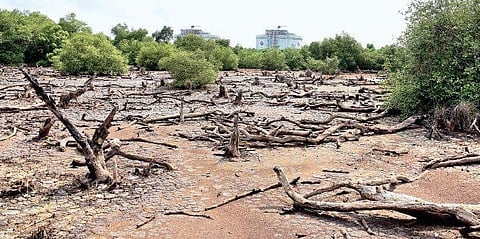

KOCHI: Never before did Kerala turn so conscious about its depleting green cover than in the wake of the recent flood. The deluge and its aftermath woke us from a deep slumber, triggering studies and debates about how the vanishing green could prove extremely detrimental. In that context, the focus naturally shifts to mangroves, the perfect weapon to combat climate change, lessen the impact of storms and preserve marine wealth.
However, the district, home to 13 true mangrove species, is witnessing a decline in its cover. According to studies, there is a sharp decline in species abundance and diversity of the plants and associates. Though the present area of mangrove cover in the city is 396 hectares, Avicennia marina, one of the abundantly found species in other parts of Kerala, is on the verge of extinction here. “Avicennia marina is found abundantly in other parts of the state but we see a sharp decline here.
There are only a few left, maybe 10,” said Rani Varghese, a research scholar, Cochin University of Science and Technology. Generally, Avicennia marina and Avicennia officinalis are the dominant species in the high-density mangrove patches. Rhizophora apiculata is also present, but is less common. The recent study points out the occurrence of E. indica along the estuaries of Kochi while it has become extinct or rare in the city.
Puthuvype mangroves
The largest area of mangrove cover is in Puthuvype with 200 hectares. But, it is also the most affected due to the construction works happening there. “The decline is mainly due to urbanisation of the city. The area around Vallarpadam and Puthuvypin had a very rich mangrove cover but the construction of International Container Transshipment Terminal and the LNG Terminal led to its deterioration,” she added.
During constructions, the salt water supply to the mangroves are cut off, causing its depletion.
Puthuvypin, Mangalavanam and Kundannur are the main three sites where mangroves are found now while the researchers say there was a time when mangroves were found abundantly in Elamakkara and Vyttila. Other affected areas are Vypin, Vallarpadam and Goshree islands.
According to environmentalist Mathew Puthussery, the mushrooming of resorts near the water bodies have proved detrimental to mangroves. “With the growing number of resorts, the mangrove density reduces. There are certain conditions which favour the growth of mangroves and construction works hamper that,” he said.On the other hand, Aroor, in the outskirts of Kochi, has a very rich species diversity.
Areas in the city
Aroor, Panangadu, Nettur, Kumbalangi, Edakochi, Kannamali, Chellanam, Kumbalangi, Valanathakadu, Mangalavanam, Bolgatty, Mulavukad, Vallarpadam, Panambukad, Puthuvypin, Vallappu, Elankunnapuzha, Cherai, Maliyankara, Sattar Island.